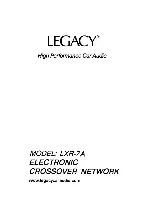
Loudspeaker crossovers
A crossover is an electrical circuit that splits the audio signal into frequency bands that are suitable for each
drive unit (so that only bass frequencies are routed to the bass unit, treble frequencies to the treble unit and
so on). If a loudspeaker had only one drive unit, then no crossover would be required, but since no single
drive unit is capable of handling the entire frequency range with any degree of accuracy, most loudspeakers
require crossover circuits.
There are two categories of crossover – passive and active (AKTIV).
Passive crossovers
If implemented well, a passive crossover can help to provide a good sound from a capable loudspeaker.
However the design of any passive crossover is, by its very nature, fundamentally limited and it can only act
as a rather basic filter. Large capacitors, inductors and resistors combine to remove unwanted frequencies
from each frequency band of the large loudspeaker-level signal in order to ensure the signal is suitable for
the drive unit. Passive crossovers can therefore only ever give out a lesser signal than is put in, since each
crossover absorbs – or worse, sometimes reflects back into the power amplifier – the parts of the signal that
it filters out. Most of the energy that is prevented, by the passive crossover, from reaching the loudspeaker
drive units is expended by the amplifier as heat. This inherent inefficiency can mean that, for some
loudspeakers, a third or more of the power produced by the amplifier is wasted by the crossover. With the
amplifier working much harder than is necessary, this greatly reduces the level of control that it has over the
drive unit, adversely affecting the system performance.
There is also the problem of the passive filter being connected between the amplifier and the drive unit.
This means that the signal is impeded – an effect that is particularly prevalent with the bass signal. Another
difficulty arises with the layout of the crossover: physical proximity of components to each other and to
other metallic parts can lead to crosstalk (signal leakage from one part of the circuitry to another) and other
unwanted effects, again compromising the performance.
Since higher volume levels tend to exacerbate all the above problems, when a passive crossover is used,
accuracy and power are limited and signal integrity is likely to be compromised.
3
Introduction
(continued)
Summary of Contents for KLIMAX AKTIV
Page 1: ...E n g l i s h KLIMAX AKTIV CROSSOVER OWNER S MANUAL ...
Page 8: ......




























